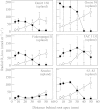Aerenchyma and an inducible barrier to radial oxygen loss facilitate root aeration in upland, paddy and deep-water rice (Oryza sativa L.)
- PMID: 12509350
- PMCID: PMC4795684
- DOI: 10.1093/aob/mcf114
Aerenchyma and an inducible barrier to radial oxygen loss facilitate root aeration in upland, paddy and deep-water rice (Oryza sativa L.)
Abstract
The present study evaluated waterlogging tolerance, root porosity and radial O(2) loss (ROL) from the adventitious roots, of seven upland, three paddy, and two deep-water genotypes of rice (Oryza sativa L.). Upland types, with the exception of one genotype, were as tolerant of 30 d soil waterlogging as the paddy and deep-water types. In all but one of the 12 genotypes, the number of adventitious roots per stem increased for plants grown in waterlogged, compared with drained, soil. When grown in stagnant deoxygenated nutrient solution, genotypic variation was evident for root porosity and rates of ROL, but there was no overall difference between plants from the three cultural types. Adventitious root porosity increased from 20-26 % for plants grown in aerated solution to 29-41 % for plants grown in stagnant solution. Growth in stagnant solution also induced a 'tight' barrier to ROL in the basal regions of adventitious roots of five of the seven upland types, all three paddy types, and the two deep-water types. The enhanced porosity provided a low resistance pathway for O(2) movement to the root tip, and the barrier to ROL in basal zones would have further enhanced longitudinal O(2) diffusion towards the apex, by diminishing losses to the rhizosphere. The plasticity in root physiology, as described above, presumably contributes to the ability of rice to grow in diverse environments that differ markedly in soil waterlogging, such as drained upland soils as well as waterlogged paddy fields.
Figures


Similar articles
-
Enhanced formation of aerenchyma and induction of a barrier to radial oxygen loss in adventitious roots of Zea nicaraguensis contribute to its waterlogging tolerance as compared with maize (Zea mays ssp. mays).Plant Cell Environ. 2012 Sep;35(9):1618-30. doi: 10.1111/j.1365-3040.2012.02513.x. Epub 2012 May 1. Plant Cell Environ. 2012. PMID: 22471697
-
Functional and chemical comparison of apoplastic barriers to radial oxygen loss in roots of rice (Oryza sativa L.) grown in aerated or deoxygenated solution.J Exp Bot. 2009;60(7):2155-67. doi: 10.1093/jxb/erp089. J Exp Bot. 2009. PMID: 19443620
-
Morphological and physiological responses of rice (Oryza sativa) to limited phosphorus supply in aerated and stagnant solution culture.Ann Bot. 2006 Nov;98(5):995-1004. doi: 10.1093/aob/mcl194. Epub 2006 Oct 11. Ann Bot. 2006. PMID: 17035284 Free PMC article.
-
Mechanisms for coping with submergence and waterlogging in rice.Rice (N Y). 2012 Feb 27;5(1):2. doi: 10.1186/1939-8433-5-2. eCollection 2012. Rice (N Y). 2012. PMID: 24764502 Free PMC article. Review.
-
Conditions leading to high CO2 (>5 kPa) in waterlogged-flooded soils and possible effects on root growth and metabolism.Ann Bot. 2006 Jul;98(1):9-32. doi: 10.1093/aob/mcl076. Epub 2006 Apr 27. Ann Bot. 2006. PMID: 16644893 Free PMC article. Review.
Cited by
-
Mechanisms of Waterlogging Tolerance in Plants: Research Progress and Prospects.Front Plant Sci. 2021 Feb 10;11:627331. doi: 10.3389/fpls.2020.627331. eCollection 2020. Front Plant Sci. 2021. PMID: 33643336 Free PMC article. Review.
-
Micro-nano oxygenated irrigation improves the yield and quality of greenhouse cucumbers under-film drip irrigation.Sci Rep. 2023 Nov 9;13(1):19453. doi: 10.1038/s41598-023-45121-3. Sci Rep. 2023. PMID: 37945608 Free PMC article.
-
Climate-smart crops: key root anatomical traits that confer flooding tolerance.Breed Sci. 2021 Feb;71(1):51-61. doi: 10.1270/jsbbs.20119. Epub 2021 Jan 6. Breed Sci. 2021. PMID: 33762876 Free PMC article.
-
O2 dynamics in the rhizosphere of young rice plants (Oryza sativa L.) as studied by planar optodes.Plant Soil. 2015;390(1-2):279-292. doi: 10.1007/s11104-015-2382-z. Epub 2015 Feb 6. Plant Soil. 2015. PMID: 26166902 Free PMC article.
-
Contrasting oxygen dynamics in the freshwater isoetid Lobelia dortmanna and the marine seagrass Zostera marina.Ann Bot. 2005 Sep;96(4):613-23. doi: 10.1093/aob/mci214. Epub 2005 Jul 18. Ann Bot. 2005. PMID: 16027129 Free PMC article.
References
-
- ArmstrongW.1964. Oxygen diffusion from roots of some British bog plants. Nature 206: 801–802.
-
- ArmstrongW.1969. Rhizosphere oxidation in rice: an analysis of intervarietal differences in oxygen flux from the roots. Physiologia Plantarum 22: 296–303.
-
- ArmstrongW.1971. Radial oxygen losses from intact rice roots as affected by distance from the apex, respiration, and waterlogging. Physiologia Plantarum 25: 192–197.
-
- ArmstrongW.1979. Aeration in higher plants. Advances in Botanical Research 7: 225–332.
-
- ArmstrongW.1994. Polarographic oxygen electrodes and their use in plant aeration studies. Proceedings of the Royal Society of Edinburgh102B: 511–527.
MeSH terms
Substances
LinkOut - more resources
Full Text Sources
Miscellaneous

